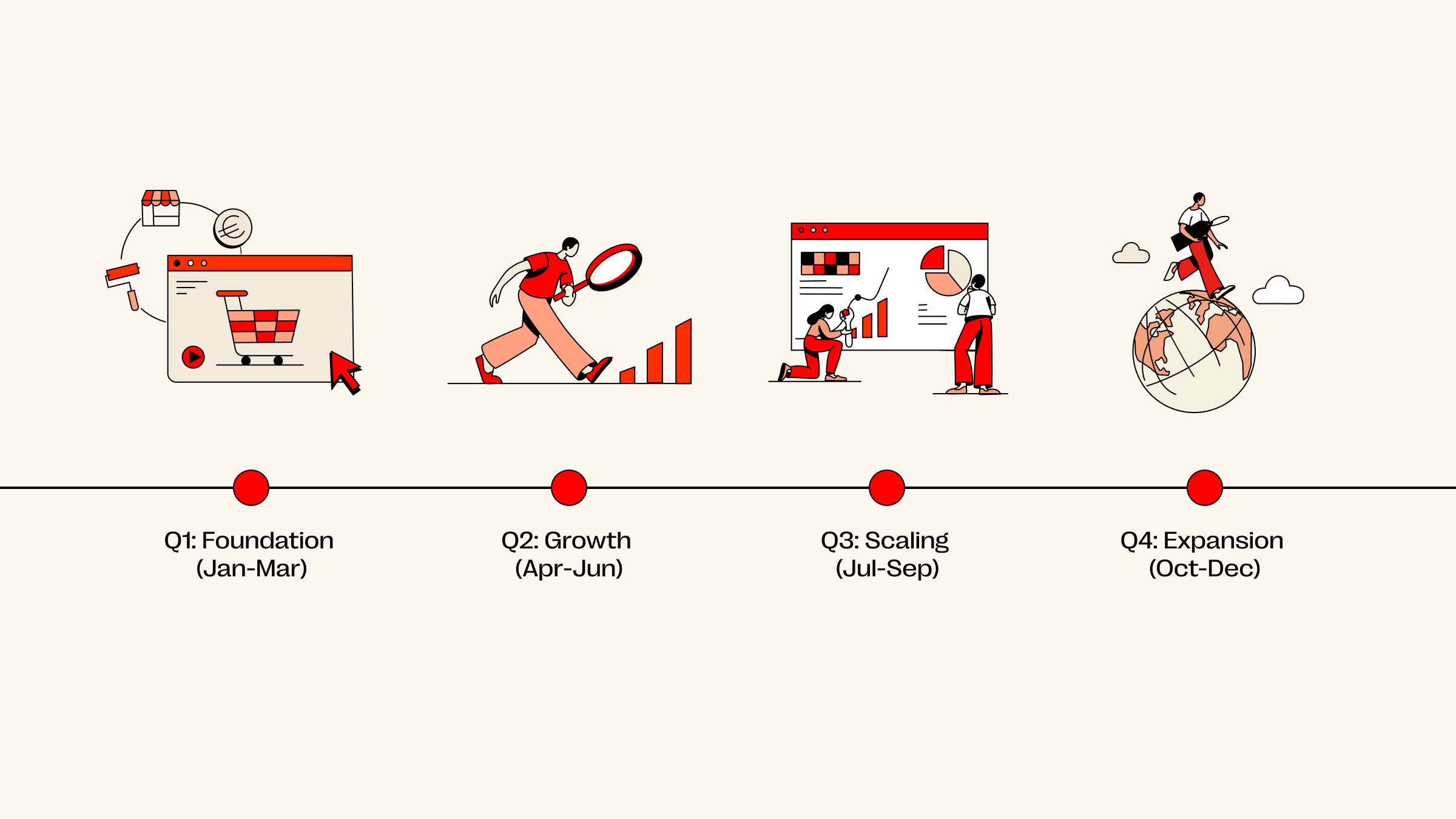Introduction
In the fast-paced world of fashion DTC, standing out isn’t just about having great designs—it’s about creating experiences that captivate and convert. Yet, many small-to-medium brands struggle with the same challenges: sky-high return rates, stiff competition, and limited budgets to compete with industry giants.
Here’s the truth: You don’t need a massive team or a six-figure marketing budget to win customers. What you do need are smart, scrappy content marketing hacks that turn passive browsers into loyal buyers—without draining your resources.
This guide is tailored for fashion entrepreneurs like you. We’ll explore low-cost, high-impact strategies—from AI-powered virtual try-ons to gamified style quizzes—that leverage Shoplazza’s built-in tools to simplify execution. Whether you’re a solopreneur or a growing brand, these tactics will help you cut through the noise, reduce returns, and drive sales.
And the best part? You don’t need to be a tech whiz. With Shoplazza’s intuitive integrations and affordable apps, even the most advanced strategies are just a few clicks away.
Ready to transform your content into a sales engine? Let’s dive in.
Hack the "Virtual Try-On" Trend with AR Content
Why It Works: Virtual try-on technology has become a game-changer for fashion DTC brands, reducing return rates by up to 25% while increasing conversion rates by 200%—allowing customers to visualize products in real time builds confidence and reduces purchase hesitation.
Real-World Inspiration: POIZON offers AR Try On feature for users to try the sneakers virtually before buying them.

Turn Customers into Models with UGC Contests
Why It Works: User-generated content (UGC) contests transform passive shoppers into active brand advocates. Studies show that UGC campaigns can increase conversion rates by 29% compared to traditional branded content, as customers trust peer recommendations more than polished ads. For fashion brands, showcasing real people wearing your clothing builds authenticity and helps potential buyers visualize how items fit diverse body types—reducing return rates and boosting confidence in purchases.
How to Implement:
-
Launch a Branded Hashtag Campaign
-
Create a unique hashtag (e.g., #MyShoplazzaStyle) and encourage customers to share photos/videos of themselves wearing your products.
-
Offer incentives like store credit, exclusive discounts, or featured spots on your website for the best submissions.
-
-
Display UGC on High-Impact Pages
-
Embed an Instagram Show directly into your Shoplazza product pages. For example, display a slide show of customer photos under each product to mimic SHEIN’s approach, where users see how clothes look on real people instead of professional models.
-
-
Amplify Top Submissions
-
Repost standout UGC on your official social channels and website. Tag the creator to foster community and incentivize further participation.
-
Example:
-
Shoplazza Integration Tips:
-
Automate Rewards: Link UGC submissions to Shoplazza’s loyalty program. For instance, award points for sharing content, which users can redeem for discounts or early access to new collections.
Real-World Inspiration:
Lulus, a popular online fashion brand, runs the #lovelulus campaign. The campaign not only fills their social feeds with authentic content but also drives traffic to product pages by linking UGC to shoppable items.
Behind-the-Scenes Storytelling for Instant Trust

Why It Works: Behind-the-scenes (BTS) content humanizes brands by revealing the people, processes, and values behind products. According to the Sprout Social Index, most consumers seek authentic content that promotes transparency around business practices and values, and BTS storytelling builds credibility by showcasing authenticity. For fashion DTC brands, this approach helps customers connect emotionally, reduces skepticism about quality, and fosters loyalty.
How to Implement:
-
Showcase Your Production Process
-
Example: Create short videos or blog posts documenting how a garment is made—from fabric sourcing to final stitching. Highlight sustainable practices or ethical labor standards.
-
Shoplazza Integration: Use Shoplazza’s blog tool to publish detailed articles with embedded videos (e.g., “How Our Organic Cotton Dresses Are Crafted”). Add a live counter for transparency (e.g., “2,342 eco-friendly dresses sold this month!”).
-
-
Introduce Your Team
-
Example: Launch a “Meet the Makers” series featuring designers, tailors, or customer service reps. Share their stories, expertise, and passion for fashion.
-
Pro Tip: Film casual interviews or day-in-the-life snippets (e.g., “A Day with Our Lead Designer”) and embed them on Shoplazza’s product pages.
-
-
Share Challenges and Solutions
-
Example: Post about a design hurdle (e.g., perfecting a zero-waste pattern) and how your team resolved it. This honesty builds relatability and positions your brand as problem-solvers.
-
A small South Asian wedding clothing brand Sani focused on sustainable apparel used BTS storytelling to highlight their fabric sourcing process. They filmed a TikTok series showing their founders visiting ethical textile mills in India, explaining how materials like organic cotton and recycled polyester are selected. Their 6th video went viral—to the tune of 3 million views—and gained Sani tens of thousands of new followers.
Gamify Shopping with Style Quizzes

Why It Works:
Quizzes generate 3x more leads than traditional forms. By gamifying the shopping experience with style quizzes, you can engage customers in a fun and interactive way, while also collecting valuable data on their preferences. This helps you tailor your marketing efforts and product recommendations to better suit their needs, ultimately driving higher conversions and customer loyalty.
Hacks:
-
Create a Style Quiz: Build a “Find Your Perfect Outfit” quiz using tools like Typeform or Interact. These platforms offer user-friendly interfaces and customizable templates, making it easy to create engaging quizzes without extensive technical skills.
-
Incentivize Participation: Offer a discount code (e.g., 10% off) upon completion of the quiz. This not only encourages more people to take the quiz but also increases the likelihood of immediate purchases.
-
Personalize Recommendations: Sync quiz results with Shoplazza’s email marketing tool to send personalized product recommendations based on the quiz answers. For example, if a customer identifies as a “Minimalist,” you can recommend minimalist-style outfits and accessories.
-
Promote on Social Media: Share the quiz on your social media channels with a catchy CTA like, “Are you a Minimalist or Maximalist? Take our 1-minute quiz to unlock your style!” This will help drive traffic to your quiz and expand your reach.
-
Embed on Your Website: Use Shoplazza’s drag-and-drop editors to embed the quiz directly onto your website or landing pages. This ensures a seamless experience for your customers and keeps them engaged within your brand ecosystem.
Example:
NYDJ, a fashion brand, sent subscribers a campaign message encouraging them to take an online quiz to find the perfect fit and style. This approach not only increased engagement but also provided valuable insights into customer preferences, which can be leveraged for future marketing efforts.
Hijack Holidays with Micro-Seasonal Campaigns

Why It Works:
Micro-seasonal campaigns allow fashion brands to tap into the holiday shopping frenzy without competing head-on with the major sales events like Black Friday or Cyber Monday. By creating smaller, targeted campaigns around specific themes or mini-holidays, you can build urgency and excitement while standing out from the crowd.
Hacks:
-
Identify Micro-Seasons and Themes:
-
Break down the holiday season into smaller, themed periods. For example, create a “Cozy Fall Week” or a “Winter Wonderland Week”.
-
Align these themes with specific holidays or trends. For instance, a “Holiday Party Prep” week leading up to Christmas or a “New Year, New Style” campaign.
-
-
Launch a Limited-Time Collection:
-
Create a 7-day capsule collection tailored to the theme of your micro-season. For example, a “Summer Escape Capsule” collection could feature lightweight, breathable clothing perfect for the last days of summer.
-
-
Offer Exclusive Incentives:
-
Pair your micro-seasonal collection with exclusive offers, such as a downloadable “Capsule Wardrobe Guide” in exchange for email sign-ups.
-
Use countdown timers and exit-intent popups on your Shoplazza store to create urgency and encourage immediate purchases.
-
-
Promote Through Targeted Channels:
-
Optimize your Pinterest pins for keywords like “summer capsule wardrobe 2025” to drive organic traffic to your micro-seasonal landing page.
-
Leverage Instagram and TikTok for short, engaging videos showcasing how to style items from your micro-seasonal collection.
-
-
Share the Story Behind the Collection:
-
Use your brand’s blog to share the inspiration behind the micro-seasonal collection. For example, if your theme is sustainability, highlight eco-friendly materials and production processes.
-
Share behind-the-scenes content or customer testimonials to build an emotional connection with your audience.
-
Example:
A fashion brand could launch a “Holiday Glamour” micro-seasonal campaign in December, focusing on elegant evening wear and accessories. The campaign could include:
-
A dedicated landing page with a “Shop the Look” carousel featuring styled outfits.
-
A downloadable “Holiday Glamour Guide” for email subscribers.
-
Countdown timers on the site to create urgency around limited-time offers.
By leveraging micro-seasonal campaigns, you can create unique shopping experiences that resonate with your audience, drive higher engagement, and boost sales during the busy holiday season.
Repurpose Top Content into Shoppable Videos

Why It Works:
Shoppable videos have a 30% higher click-through rate (CTR) than static ads. By transforming your top-performing content into interactive shoppable videos, you can significantly enhance customer engagement and drive higher conversions. These videos allow customers to explore and purchase products directly from the video, creating a seamless shopping experience.
Hacks:
-
Identify Top-Performing Content:
-
Review your analytics to identify which blog posts, social media posts, or product pages have the highest engagement and traffic.
-
Look for content that showcases your products in a visually appealing way, such as styling guides, lookbooks, or customer testimonials.
-
-
Create Shoppable Videos:
-
Use tools like Fireworks to create interactive videos. This tool allows you to make videos from viewable to shoppable.
-
Film short, engaging videos (15-30 seconds) that highlight multiple ways to style a single product. For example, show three different outfits using the same dress or jacket.
-
Ensure the video player includes a seamless purchase process, such as shopping cards displayed below the video in full-screen mode.
-
-
Repurpose Across Multiple Platforms:
-
Share your shoppable videos on multiple platforms to maximize reach. For example, post them on TikTok, Instagram Reels, and YouTube Shorts.
-
Use Pinterest Idea Pins to repurpose your top-performing videos, targeting keywords like “2025 fashion trends” or “how to style [product]”.
-
-
Track and Optimize Performance:
-
Use Shoplazza’s Analytics Dashboard to track which videos drive the most sales. Monitor key metrics like views, engagement, and conversion rates.
-
Use these insights to refine your video content strategy and optimize future campaigns for better performance.
-
Example:
A fashion brand could take a popular blog post titled “5 Ways to Style Your Favorite Denim Jacket” and transform it into a shoppable video. The video would showcase five different outfits using the same denim jacket, with each item tagged for purchase. Viewers could click on any item directly from the video, making the shopping experience seamless and engaging.
Leverage Abandoned Cart Data for Hyper-Targeted Content

Why It Works:
Abandoned cart emails have a 45% open rate, making them one of the most effective ways to recover lost sales. By leveraging the data from abandoned carts, you can create hyper-targeted content that addresses customers' specific interests and hesitations, ultimately encouraging them to complete their purchases.
Hack:
-
Create a "Second Chance" Lookbook:
-
Use Shoplazza’s automation tool to trigger personalized emails for cart abandoners. Include a subject line like “Your Dream Outfit is Almost Gone!” to grab their attention.
-
Design a visually appealing lookbook that features the items left in their cart, along with complementary products. For example, if they abandoned a dress, show it styled with matching shoes and accessories.
-
-
Personalize with Video:
-
Include a short video in the email showcasing someone wearing the abandoned item. This helps customers visualize the product in use and can significantly increase the likelihood of a purchase.
-
-
Offer Limited-Time Incentives:
-
Provide a limited-time discount or free shipping on the items in their cart to create urgency and encourage immediate action.
-
Highlight the exclusivity of the offer, emphasizing that it’s only available for a short period or for the next few customers who complete their purchase.
-
-
Remind and Reassure:
-
Remind customers of the benefits of the products they left behind, such as unique features, customer reviews, or sustainability practices.
-
Address potential hesitations by including a customer testimonial or a guarantee, like a 30-day return policy.
-
-
Track and Optimize:
-
Use analytics tools to track the performance of your abandoned cart emails. Monitor metrics like open rates, click-through rates, and conversion rates.
-
Test different subject lines, content formats, and offers to see what resonates best with your audience and optimize your strategy accordingly.
-
Example:
Imagine a customer added a pair of stylish sneakers to their cart but didn’t complete the purchase. You could send them an email with a subject line like “These Sneakers Were Made for You!” The email would include:
-
A short video of a model wearing the sneakers, walking and jumping to show off the features.
-
A personalized lookbook featuring the sneakers styled with different outfits.
-
A limited-time 10% discount on the sneakers, valid for the next 24 hours.
-
A reminder of your 30-day return policy to ease any concerns.
By leveraging abandoned cart data to create hyper-targeted content, you can turn potential lost sales into completed purchases, while also building stronger relationships with your customers through personalized, relevant messaging.
Looking for more ways to boost your fashion DTC brand? Stay ahead of the curve with the latest content marketing strategies for apparel brands. Don't miss out on the opportunity to drive more traffic, engage your audience, and increase your bottom line. Start your journey with Shoplazza today!



